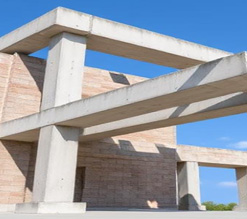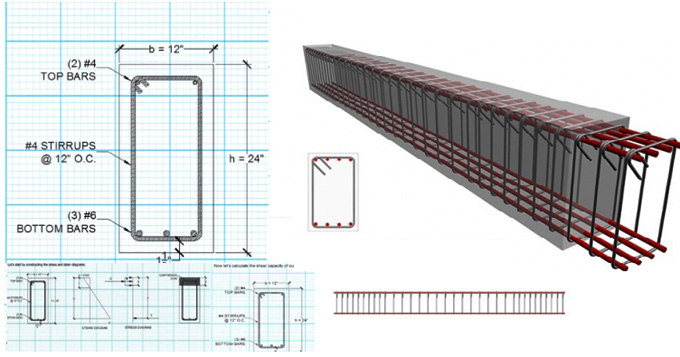
Types of Concrete Beams and their Reinforcement Details

Concrete beams are the structural members of the building structure, which help to transmit the overall load of the construction structure. Different types of concrete beams have been used in the building structure, which are as follows-

1. Simple concrete beam
2. ontinuous concrete beam
3. Semi-continuous concrete beam
4. Cantilever concrete beam
5. T-beam
Process of designing a concrete beam
The design of the concrete beam has been done in several steps, which are as follows:
➢ At first, the intensity of the load that is expected to act on the beam should be calculated. In this context, transferable loads should be added from the slab to the beam to find out the intensity of the load.
➢ After that, the effective span of the beam should be determined.
➢ The trial dimensions of the beam should be estimated in the next step.
➢ In the next step, the depth of the beam should be determined. In this context, it should be ensured that the provided depth of the beam is equal to or greater than the minimum depth and if the condition is not met, then this section should be redesigned.
➢ In the next step, the amount of reinforcement should be estimated, and after that, the cross-sectional area of the single steel bar should also be estimated. This helps to find the number of bars that are required for bending.
➢ After that, the nominal shear stress and permissible shear strength of the beam should be found out, and the spacing of the shear reinforcement should be determined.
➢ In the next step, the serviceability of the beam should be checked, including checking for deflection and cracking in the concrete beams. Thus, the entire design procedure for the concrete beam has been completed, and the detailed design data and reinforcement detailing should be provided.
Discuss different types of RCC beams
The reinforced concrete (RCC) beams refer to the inclined structural member or horizontal structural member of the concrete structure, which has been designed to carry the loads of walls, slabs and roof of the building structure. The RCC beams help to transfer the loads of the slabs, walls and roofs to the column and foundation of the building structure. In the RCC beams, the reinforcement inside the beam helps to resist the tension forces, and also the concrete in the beams helps to resist the compression forces. The RCC beams have been classified into different types, which are as follows:
On the basis of the support conditions
Simply Supported Beam
These types of RCC beams rest on the two supports and help to transfer the load of the construction structure into them.
Continuous Beam
The continuous beams have been supported on multiple points, which also helps to reduce the bending moments.
Cantilever Beam
These types of RCC beams have been used in the sunshades, balconies or in the overhangs.
Fixed Beam
The fixed beam helps to provide extra stability to the building structure.
On the basis of the cross-section
Rectangular Beam
The rectangular beam is easy to construct and has been used in commercial and residential buildings.
Circular Beam
These types of RCC beams have been used in domes, chimneys, and water tanks and provide aesthetic appeal.
L-Beam
In the edges of the slabs, this type of RCC beam has been used to provide additional support to the construction structure.
T-Beam
A T-beam is used in heavy-load structures and helps to make the slab stronger.
On the basis of the reinforcement types
Singly Reinforced Beam
This kind of reinforcement has been provided in the tension zone.
Doubly Reinforced Beam
This kind of reinforcement has been provided in the compression zone of the beam.
Under Reinforced Beam
In this case, more reinforcement has been given in the tension zone as compared to the compression zone.
Over Reinforced Beam
In this case, more reinforcement has been given in the compression zone rather than the tension zone of the beam.
To learn more, watch the following video tutorial.
Video Source: CalcBook
Learn about the different types of support
The support refers to that element of the building structure which is responsible for providing stability, stiffness and strength to the entire building structure. These supports of the construction structure help to resist the internal forces and also help to transmit the load to the ground. Different types of supports have been used in the beams, which are as follows:
Fixed support
The fixed support helps to resist the horizontal and vertical forces of the building structure. Fixed support helps to prevent both rotation and translation; as a result, it is known as the rigid support.
Pinned support
The pinned support helps to resist both horizontal and vertical forces. This type of support has been used to prevent translation.
Roller support
These types of support can be rotated and translated along with the resting surface of the roller. The roller support is not able to resist the lateral forces. In the case of not providing the roller support in the bridge structure, the bridge’s bank will be severely damaged. In this context, at least one roller support should be given at one end of the bridges along with another support to prevent translation.


